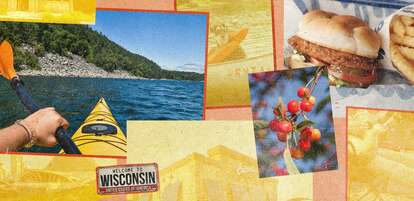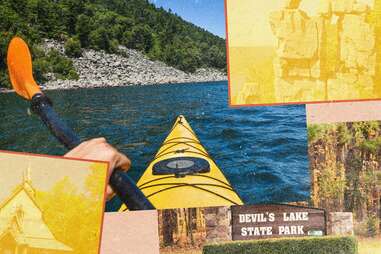

The 13 Places You Need to Visit to Truly Experience Wisconsin
From comfort food to gorgeous coastlines, Wisconsin does have it all.

There’s a saying at Wisconsin’s largest university: When you say Wisconsin, you’ve said it all. A parody of an erstwhile beer ad, the expression originated as a taunt to the university’s sports rivals — but we’d argue it applies to the whole state. Home to glorious landscapes, beloved sports teams, rich agricultural happenings, and more than 140 spots to get the state’s best comfort food (yes, we’re talking about Culver’s), Wisconsin really does have it all. Here’s how to see and experience it for yourself.
There’s a reason Door County is described as the “Cape Cod of the Midwest”: The Lake Michigan peninsula provides panoramic water views, lighthouses aplenty, and breathtaking beaches up and down its shores. But there’s more to this destination’s coastal charm: Summers in Door County are all about the abundant cherry harvest, but explorers should hop the ferry to the 35-square-mile Washington Island for a stop at the lavender festival and Wisconsin’s oldest continuously operating tavern. On the mainland, a hike through the cedar, sugar maple, and red oak groves at Peninsula State Park is a must, and no Door County weekend is complete without a traditional fish boil.
If Door County is the Cape Code of the Midwest, then the Wisconsin Dells is almost certainly the child of Niagara Falls and Pigeon Forge, Tennessee. Kitsch abounds in this, the so-called “Waterpark Capital of the World,” where you can spend sunny days flouncing through the chlorinated waters at the 70-acre, summers-only Noah’s Ark Water Park or various indoor/outdoor resorts. Even in the wintertime, the Dells’ dozens of indoor water-based lodges keep the good vibes — and waterslides — flowing, despite the state’s notoriously frigid temps. While quirk is in no short supply here (just traipse through downtown to see rows of fanciful tourist shops), we prefer the scenic route: Boat tours of the Upper and Lower Dells let spectators ooh and aah over the hypnotic sandstone formations carved over time by the Wisconsin River.
Little unites locals like our love of a certain football team (seriously, need we even name them?), and Lambeau Field is the green-and-gold beacon of our Green Bay team’s success. For football fans spoiled by warm climates and retractable roofs, Cheeseheads’ love of Lambeau might seem incomprehensible: The open-air, 81,441-seat stadium and frigid temperatures have earned it the nickname the Frozen Tundra. Yet we return time and time again for game day. Why? It might be to cheer on the sporting juggernaut that Vince Lombardi built. Some swing by to celebrate Wisconsin’s time-honored tradition of tailgating. But there’s something in Lambeau Field that makes it a sacred space all its own — why else would fans store boxes of the field’s original dirt and grass in their freezers as keepsakes?

The crown jewel of Wisconsin’s state park system, Devil’s Lake State Park in Baraboo is a one-stop shop for nature lovers. The park’s more than 10,000 acres are home to 29 miles of hiking trails, including an 11-mile leg of the Ice Age Trail; stunning glacial rock formations; scenic overlooks; and more than 400 (perennially booked) campsites. It all surrounds the eponymous lake, whose pristine waters are guarded by bluffs that make them ideal for kayaking, paddleboarding, and uninterrupted fishing. Our recommendation? Avoid the tourists in summer and trek through in fall, when the surrounding forests’ rich amber, marigold, and scarlet leaves are at full peak.
Off the state’s northernmost tip in Lake Superior lie the Apostle Islands, a chain of 21 land masses lauded for their scenic rock formations and secluded beaches. In the summer months, it’s not uncommon for Wisconsinites to hop in a kayak to see the grooved sandstone formations and paddle out to make camp on an island shore. The destination spot exudes a kind of mystical energy all year round, but it’s wintertime when the real magic happens: Lake Superior freezes over, allowing visitors to trek — carefully — between the islands. Feeling lucky? If conditions are just so along the Mainland Unit, you might even catch a glimpse of some ice caves, which are adorned with massive ice spikes, curtains, and crystals.

Since 1984, Culver’s has dished out some of the country’s best burgers and custard right from America’s Dairyland. Founded and headquartered in Sauk City, the restaurant made a name for itself thanks to its attention to quality, local ingredients — including the cheese for its fried curds — and its crave-worthy ButterBurger. As the restaurant expands across the country, its blue and white signage has become synonymous with Wisconsin’s culinary comforts. Items like the North Atlantic Cod Dinner let diners take part in the state’s most sacred tradition, the Friday fish fry, any night of the week. Looking to go full Sconnie? Sub your fries for an order of cheese curds, and wash it down with a Chocolate Shake — now you’ve got yourself a true taste of Wisconsin.
Architecture buffs looking to get their fill of beautiful buildings — from the traditional to the bizarre — needn’t drive farther than Spring Green. Nestled in the state’s Driftless Area is one of Frank Lloyd Wright’s most infamous structures: Taliesin. Now home to the Frank Lloyd Wright School of Architecture, the 37,000-square-foot estate is known as much for its various tragedies as it is for the cantilevers and limestone adornments that make it an iconic Wright design. Those seeking a bit more eccentricity (and levity) should head south to the House on the Rock, a smorgasbord of sights and sounds created by Alex Jordan, Jr. in 1959. A time capsule of midcentury design, complete with stained glass everything and carpeting... everywhere, the house is best recognized for its collections of oddities, massive indoor carousel, and the Infinity Room — a 281-foot, windowed armature that extends over a tree-filled valley.
New Glarus is the place to be in September, when Oktoberfest takes over the town for an abbreviated version of the German festival. Locals and visitors don their best dirndl and lederhosen, bounce to polka bands, and partake in all of the suds-soaked revelry of the season. No beer-related visit to the town is complete without a tour of New Glarus Brewing Company, where you can peep the German-imported copper kettles used to create some of the state’s most beloved potables. Of course, there’s more to do in “America’s Little Switzerland” than sample beers: Peep the Swiss chalet-style buildings and stop into quaint stores on a casual stroll through the village’s main drag, or use the town as the pushing-off point for your 23-mile bike ride down the Sugar River State Trail.
Wisconsin has its share of building bona fides, but the Milwaukee Art Museum takes the title of the Forward State’s most avant-garde architectural wonder. An amalgam of structures, including a boxy, midcentury number designed by Eero Saarinen, the museum is best recognized by Spanish architect Santiago Calatrava’s 142,050-square-foot Quadracci Pavilion. With sculptural lines and movable, protective wing-like structures on the exterior, the behemoth of concrete, glass, and white steel evokes an ibis delicately alighting on the shores of Lake Michigan. It’s a vision of majesty and wonder — one that’s indelibly shaped Milwaukee’s skyline since its construction in 2001.

In a state with 14.3 million acres of land devoted to everything from dairy cattle to ginseng, there is no one farmstead that captures Wisconsin’s rich and varied agricultural heritage. To get a full view of what makes the state an exemplar of America’s heartland, swing by the Farm Wisconsin Discovery Center in Manitowoc. The museum is rife with activities perfect for little ones, including a local dairy farm tour and hands-on exhibits about conservation and agricultural technology. The experience culminates with a visit to the birthing barn, where, if you’re lucky, you might even witness the delivery of a calf.
A celebration of the state’s rich agricultural heritage, the Dane County Farmers’ Market in Madison is the big Saturday to-do — where everything on offer has been grown, sewn, preserved, baked, or harvested solely by the sellers. More than 150 vendors line the sidewalks circling the state Capitol Building, peddling everything from veggies and local honey (note the Bee Hat Man) to traditional Mennonite pastries and hot and spicy cheese bread (when you hear the vendor shouting those very words, don’t ask questions — just go). The market is also a hot spot for wagon-pulling chefs and stroller-pushing parents alike, so watch your toes.
Ski bunnies aren’t without options in this snow-bound state, but no resort stands above Alpine Valley — and it’s not just for the slopes. Sure, the skiing’s good at this southeast Wisconsin resort’s 90 acres, but Alpine Valley has become better known as a tour stop for big-time bands heading to or from nearby Milwaukee and Chicago. Over the years, the 37,000-capacity venue has played host to a diverse array of music acts, including Stevie Ray Vaughan in his final performance, and, recently, the 2019 Farm Aid music festival.
Rhinelander, a small logging town in the northeast reaches of the state, is the proud home of a unique bit of Wisconsin folklore: the hodag. Part frog and part dinosaur, the horned, thick-fanged, dog-sized critter was “discovered” by Eugene Shepard in 1893 as part of a short-lived hoax — but the legend lives on to this day. And Rhinelander has really leaned in: Country artists flock north for the three-day Hodag Country Festival, and the city’s website is plastered with homages to the mysterious (and, okay, cute) creature. But the most recognizable symbol lies in wait outside the Chamber of Commerce, where a massive hodag sculpture gamely stands guard, bearing an ear-to-ear grin that just begs for a selfie.